Non-Patterned Equipment: Slings for Rifles, LMG, SMG
Introduction
 Collectors almost universally refer to the webbing versions of rifle slings as either Patt. '08 W.E., or Patt. '37 W.E. Slings, dependent on the dates stencilled-on. At no stage in its long history (1901-1991) was the rifle web sling ever given a Pattern Year. Bucking this trend, the same Sling, but in blue-grey for the R.A.F., was approved as Sling, rifle, web, R.A.F. Pattern 1925. By the same token, the Sling, rifle, Pattern, 1914 was not part of Pattern 1914 Infantry Equipment. The photograph at left, taken at Gallipoli, 1915, shows British troops carrying their S.M.L.E. Rifles using Slings, rifle, web, G.S.
Collectors almost universally refer to the webbing versions of rifle slings as either Patt. '08 W.E., or Patt. '37 W.E. Slings, dependent on the dates stencilled-on. At no stage in its long history (1901-1991) was the rifle web sling ever given a Pattern Year. Bucking this trend, the same Sling, but in blue-grey for the R.A.F., was approved as Sling, rifle, web, R.A.F. Pattern 1925. By the same token, the Sling, rifle, Pattern, 1914 was not part of Pattern 1914 Infantry Equipment. The photograph at left, taken at Gallipoli, 1915, shows British troops carrying their S.M.L.E. Rifles using Slings, rifle, web, G.S.
Sling, rifle, web, G.S. (Mark I.) [First issue]
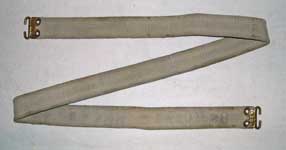 The Sling, rifle, web, G.S. (Mark I) was introduced by L. of C. §10442, approved 31st January 1901, with a secondary date of 7th February 1901. At 46-inches long by 1 ¼-inches wide, this Sling is a shorter version of a rifle sling originally produced by the US Mills & Orndorff Company. That 60-inch long sling has been stated to be a "tropical" sling intended for use with the U.S. Krag rifle, although there is some controversy over that. It has also been stated that the long U.S. made version was used by the British during the 2nd Boer War, but this is un-confirmed. At the time, Mills in the U.K. was a subsidiary of Mills in the U.S.A. It is entirely plausible that, to meet demand, supplies were made by both companies. Whatever the precise facts, it was the very first Web rifle sling to appear in the List of Changes. Shown here is the first issue version, with the distinctive short, eyeletted 3/4-inch Catches, web sling. This type was not dated and, since it precedes the founding of the Mills Equipment Company, it has the U.S. style Mills & Orndorff name and patent markings, which were all that could be used by the London subsidiary. From the Karkee Web Collection.
The Sling, rifle, web, G.S. (Mark I) was introduced by L. of C. §10442, approved 31st January 1901, with a secondary date of 7th February 1901. At 46-inches long by 1 ¼-inches wide, this Sling is a shorter version of a rifle sling originally produced by the US Mills & Orndorff Company. That 60-inch long sling has been stated to be a "tropical" sling intended for use with the U.S. Krag rifle, although there is some controversy over that. It has also been stated that the long U.S. made version was used by the British during the 2nd Boer War, but this is un-confirmed. At the time, Mills in the U.K. was a subsidiary of Mills in the U.S.A. It is entirely plausible that, to meet demand, supplies were made by both companies. Whatever the precise facts, it was the very first Web rifle sling to appear in the List of Changes. Shown here is the first issue version, with the distinctive short, eyeletted 3/4-inch Catches, web sling. This type was not dated and, since it precedes the founding of the Mills Equipment Company, it has the U.S. style Mills & Orndorff name and patent markings, which were all that could be used by the London subsidiary. From the Karkee Web Collection.
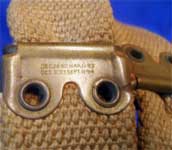
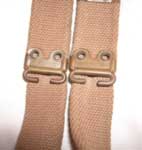
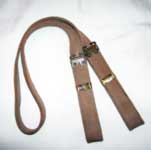 An example of the 60-inch (nominal length) Mills & Orndorff Sling mentioned above. At present, the claim that this Sling was used by British forces during the Boer War has not been substantiated, although it seems quite possible, given that during the war the Mills Woven Cartridge Belt Company of London, England was importing large numbers of Rifle slings, Water bottle slings, and various Cartridge belts and Bandoliers from the US firm. It is not clear, however, whether the imported Rifle slings were this long version or Slings, rifle, web, G.S. (Mark I). With its distinctive brass keepers, this type of Sling should be distinguishable in period photos. Can any reader supply photographic evidence of its use by British Forces? This example is from the Chris Pollendine Collection. Photographs © Chris Pollendine 2012.
An example of the 60-inch (nominal length) Mills & Orndorff Sling mentioned above. At present, the claim that this Sling was used by British forces during the Boer War has not been substantiated, although it seems quite possible, given that during the war the Mills Woven Cartridge Belt Company of London, England was importing large numbers of Rifle slings, Water bottle slings, and various Cartridge belts and Bandoliers from the US firm. It is not clear, however, whether the imported Rifle slings were this long version or Slings, rifle, web, G.S. (Mark I). With its distinctive brass keepers, this type of Sling should be distinguishable in period photos. Can any reader supply photographic evidence of its use by British Forces? This example is from the Chris Pollendine Collection. Photographs © Chris Pollendine 2012.
Sling, rifle, web, G.S., Mark I. [Second issue]
Sling, rifle, web
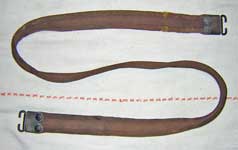
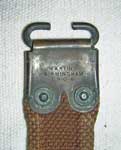 The Sling, rifle, web, G.S. (Mark I) was altered by List of Changes entry L. of C. §12060, dated 13th November 1903, and 1st January 1904. The design change increased the length of the brass Catches, web sling, on the ends from 3/4-inch long to 1 ¼-inch, in order to use hose rivets in place of the original shell rivets. The mark number was not advanced, but the brackets were dropped and, before 1910, both “G.S.” and “Mark I” had been quietly dropped. The photo at left shows a very early Sling, rifle, web, G.S. (Mark I), second issue. This example is dated 1904 and maker marked "MARTINS / BIRMINGHAM". Martins of Birmingham were well known makers of leather accoutrements, but this is the only example Karkee Web has seen of their webbing production. In spite of the early date, is is a perfectly normal second issue Sling, made from beaded edge webbing. The detail photo shows the end fittings, which are the standard second issue type. It seems unlikely that a leather maker would have had the looms to produce this type of sophisticated web, and we can't help but speculate that Martins were either buying the pieces out from Mills or working with them under a contract arrangement. If you look closely, you'll note that the rivets on the lower end piece look odd. That's because at some point in the Sling's lifetime, it has been repaired and those rivets replaced.
The Sling, rifle, web, G.S. (Mark I) was altered by List of Changes entry L. of C. §12060, dated 13th November 1903, and 1st January 1904. The design change increased the length of the brass Catches, web sling, on the ends from 3/4-inch long to 1 ¼-inch, in order to use hose rivets in place of the original shell rivets. The mark number was not advanced, but the brackets were dropped and, before 1910, both “G.S.” and “Mark I” had been quietly dropped. The photo at left shows a very early Sling, rifle, web, G.S. (Mark I), second issue. This example is dated 1904 and maker marked "MARTINS / BIRMINGHAM". Martins of Birmingham were well known makers of leather accoutrements, but this is the only example Karkee Web has seen of their webbing production. In spite of the early date, is is a perfectly normal second issue Sling, made from beaded edge webbing. The detail photo shows the end fittings, which are the standard second issue type. It seems unlikely that a leather maker would have had the looms to produce this type of sophisticated web, and we can't help but speculate that Martins were either buying the pieces out from Mills or working with them under a contract arrangement. If you look closely, you'll note that the rivets on the lower end piece look odd. That's because at some point in the Sling's lifetime, it has been repaired and those rivets replaced.
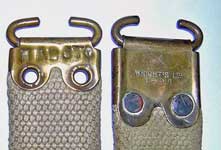
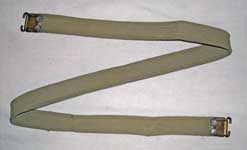 A comparison of the first issue (far left) and second issue (near left) G.S. Mk. I Rifle sling. The modifications to the end fittings noted above are the only differences. The first issue Sling is the undated M.W.C. B. one shown above. This second issue example is maker marked "WRIGHT'S LTD." and dated 1908.
A comparison of the first issue (far left) and second issue (near left) G.S. Mk. I Rifle sling. The modifications to the end fittings noted above are the only differences. The first issue Sling is the undated M.W.C. B. one shown above. This second issue example is maker marked "WRIGHT'S LTD." and dated 1908.
At right, a typical Great War example, this Sling is maker marked "M.E. Co." and dated 1915. All from the Karkee Web Collection.
Sling, rifle, New Zealand "Pattern 1913"
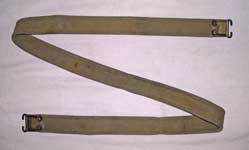
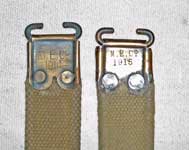 Barry and Mathew O'Sullivan, in their book New Zealand Army: Personal Equipment 1910 - 1915, refer to this Sling as the Sling, Rifle, 1913 Pattern (p. 103). It is not listed in either the A.J.H.R.* 1913, Section H19, or A.J.H.R. 1914, Section H19, as one of the components of the New Zealand Web Equipment, Pattern 1913 (Mills Web Modified Pattern Equipment) (see O'Sullivan, op. cit., p. 25). Barry has confirmed to KW that the "Pattern 1913" designation is not an official one, but is a collectors' nomenclature that he has used to differentiate the Kiwi issue from the standard G.S. sling. This variation of the second issue Sling, rifle, web, G.S. (Mark I), shown left, is identical to the normal second issue G.S. sling, except that the brass fittings are blackened. This example is maker marked "M.E. Co." and dated 1914.
Barry and Mathew O'Sullivan, in their book New Zealand Army: Personal Equipment 1910 - 1915, refer to this Sling as the Sling, Rifle, 1913 Pattern (p. 103). It is not listed in either the A.J.H.R.* 1913, Section H19, or A.J.H.R. 1914, Section H19, as one of the components of the New Zealand Web Equipment, Pattern 1913 (Mills Web Modified Pattern Equipment) (see O'Sullivan, op. cit., p. 25). Barry has confirmed to KW that the "Pattern 1913" designation is not an official one, but is a collectors' nomenclature that he has used to differentiate the Kiwi issue from the standard G.S. sling. This variation of the second issue Sling, rifle, web, G.S. (Mark I), shown left, is identical to the normal second issue G.S. sling, except that the brass fittings are blackened. This example is maker marked "M.E. Co." and dated 1914.
A comparison of the New Zealand "Pattern 1913" Rifle sling (near right ) and a standard second issue G.S. Mk. I sling (far right). You can see the blackened end fittings on the New Zealand issue Sling. The "Pattern 1913" Rifle sling is the 1914 M.E.Co. one shown at left. The second issue G.S. Mk. I example is maker marked “M.E.Co." and dated 1915. All from the Karkee Web Collection.
*Appendix to the Journal of the House of Representatives, Section H19, Annual Report of the General Officers commanding New Zealand Military Forces.
Stores Ref. A1/AA 1657 Sling, rifle, web
Cataloguing in Section 1A of the Priced Vocabulary of Stores Used In His Majesty’s Service changed, in 1924, to Section A1 Accoutrements and Musical Instruments of the Vocabulary of Army Ordnance Stores, absorbing the old P.V.O.S. Section 1B Musical Instruments in the process. The cataloguing relied solely on Nomenclature, but around 1934, Stores Codes started to be allocated. The entire Vocabulary, which was alphabetically listed, took sequential codes, with gaps for expansion. Thus items introduced later could be fitted-in – alphabetically – even ahead of earlier introductions, to maintain the alphabetic order. The later Sling, Lewis Gun therefore took the lower code A1/AA 1648 and the even later Sling, Bren gun would be A1/AA 1640. The Sling, rifle, Patt. ’14 , introduced 13 years after its web counterpart, therefore became A1/AA 1656.
Stores Ref. B1/AA 1657 Sling, rifle, web
Stores Ref. B1/1005-99-960-3065 Sling, rifle, web, khaki drab
Its long association with Section A1 was terminated by A.C.I. 36/1944, which directed a transfer – incorrectly - to V.A.O.S. Section B2 Small Arms Accessories, Tools and Packages, when it actually went to Section B1 Small Arms and their components.
Stores Ref. CN/AA 1657 Sling, rifle, web [both drab and olive drab]
Local Cat. No. BM 7116 Sling, rifle, web, khaki drab
Stores Ref. B1/1005-99-960-3065 Sling, rifle, web, khaki drab
Stores Ref. CN/1005-99-960-3065 Sling, rifle, web, khaki drab
In 1951, V.A.O.S. Section A1 Accoutrements and Steel Helmets was transferred to a new Section CN, still titled Accoutrements and Steel Helmets, but now in the Catalogue of Clothing and Necessaries. However, the Rifle sling remained as V.A.O.S. Section B1. L. of C. §C9369, approved 24th July, 1957 / 30th June, 1959. announced a change to a Joint Service Catalogue Number B1/1005-99-960-3065. These became better known as N.S.N., or N.A.T.O. Stock Number. The colour was added to differentiate it from an olive drab (dark green) Sling (see below). Typically, the Army did not provide for the future collector, as both shades were A1/AA 1657. In a cavalier manner, the Army gave the code 1757 to the upstart green sling! With a single instance to the contrary, the Army cared not a fig for its accoutremental history, thereby moving the goalposts for the collector wanting a discrete code!
L. of C. §C9501 with approval dates of 28th May and 2nd June 1958, 12th December 1958 and 5th October, 1959, all in reference to the Bren Gun and in which the khaki drab Bren sling was made obsolete. Since the Bren sling was made up using a Rifle sling, it has to be supposed that, by default, the Rifle sling became obsolete. No L. of C. has been noted which confirms this. Equally, no documentation has been seen regarding the transfer of all Slings to Section CN, of what was now the Catalogue of Ordnance Stores and Ammunition (C.O.S.A.). From 1976 onwards an extensive range of Slings, small arms are listed, but not the khaki drab Rifle sling, or the olive drab version. It is therefore interesting that both suddenly appeared again, in 1991 - marked as obsolescent – and equally suddenly disappear again by 1993. The 1991 C.O.S.A. was issued in May 1991, so predates the official start – 2 August 1991 - of the “Gulf One”. There were no khaki Slings at the time, so was the drab re-introduced as an expedient? All the P.L.C.E. was in olive drab, so even the O.D. Sling would be understandable. Any reader know why?
By virtue of its re-introduction, the Rifle sling became the oldest accoutrements still in service with the Army – 90 years. However, it lost this record to the Bandolier Equipment Waist belt, which was still going strong in 1999.
Stores Ref. B1/1005-99-960-3066 Sling, rifle, web, olive drab
Stores Ref. CN/1005-99-960-3066 Sling, rifle, web, olive drab
 This was introduced by L. of C. §C9369, approved 24th July, 1957 / 30th June, 1959. This announced a change to a Joint Service Catalogue Number, changing the khaki drab Sling also (see above). The Detail for both colours was extensive, covering use with Bren Guns, Bren Tripods, Rifle Nos. 1, 2, 4 and 5, the 3.5-in. M-20 Rocket Launcher and the Rifle, 7.62 mm., L1A1, or S.L.R. (Self Loading Rifle). Unlike the drab version, the olive drab – effectively dark green – Sling was “…Restricted for use in jungle areas and with commandos and airborne troops…”. At this time, the Army were about to issue the new dark green Pattern 1958 Web Equipment, but most were still wearing drab Patt. ’37 W.E., so drab slings made sense. Airborne troops used dark green Patt. ’44 W.E., as it was a lightweight webbing, so worn as a matter of routine, not as a “theatre issue” for jungle areas. The L. of C. infers that Commandos also wore Patt. ’44, or maybe as elite troops, they got the first issues of Patt. ’58. Any reader know?
This was introduced by L. of C. §C9369, approved 24th July, 1957 / 30th June, 1959. This announced a change to a Joint Service Catalogue Number, changing the khaki drab Sling also (see above). The Detail for both colours was extensive, covering use with Bren Guns, Bren Tripods, Rifle Nos. 1, 2, 4 and 5, the 3.5-in. M-20 Rocket Launcher and the Rifle, 7.62 mm., L1A1, or S.L.R. (Self Loading Rifle). Unlike the drab version, the olive drab – effectively dark green – Sling was “…Restricted for use in jungle areas and with commandos and airborne troops…”. At this time, the Army were about to issue the new dark green Pattern 1958 Web Equipment, but most were still wearing drab Patt. ’37 W.E., so drab slings made sense. Airborne troops used dark green Patt. ’44 W.E., as it was a lightweight webbing, so worn as a matter of routine, not as a “theatre issue” for jungle areas. The L. of C. infers that Commandos also wore Patt. ’44, or maybe as elite troops, they got the first issues of Patt. ’58. Any reader know?
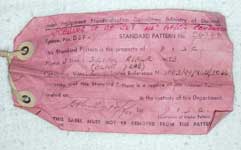
 The example shown here is a Standard Pattern example, maker marked "B.I.S." and dated 1963. Unfortunately, the black on dark green markings are barely discernable in person, and didn't photograph legibly. Details of the pattern label are shown at left. Interestingly, the last issue date, when it was sent to Remploy, is 8/9/70. From the Karkee Web Collection.
The example shown here is a Standard Pattern example, maker marked "B.I.S." and dated 1963. Unfortunately, the black on dark green markings are barely discernable in person, and didn't photograph legibly. Details of the pattern label are shown at left. Interestingly, the last issue date, when it was sent to Remploy, is 8/9/70. From the Karkee Web Collection.
Stores Ref. CN/1005-99-135-6757 Sling, small arms, webbing textile with Detail of
Two prong hook type natural colour
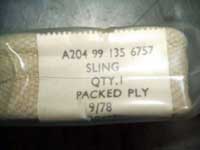
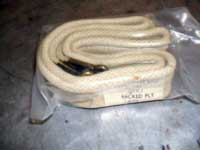 This appears in the 1976 and originally presented us with something of a mystery. The term “…webbing textile…” elsewhere in COSA means that this is cotton webbing. By its Detail “…natural colour…”, we at the time assumed to mean khaki. Similarly “…Two prong hook type…” suggests the standard Catch, web sling. Thus far, it appears to duplicate 1005-99-960-3065, so why the additional code? We got an inkling of the truth when we first saw "natural colour" meant "undyed" in reference to some RAF equipment, so we began to suspect this code referred to white Slings. Eagle eyed reader Kevin Adams was able to demonstrate this was correct when he spotted the Sling at left on that well known internet auction site. At our request, he opened the packet and his Sling itself is undyed, naturally white, but is unmarked and undated. These sealed bags appeared in several more auctions, though, and we were able to acquire two more packets, each containing five Slings. None of them were marked with this code either, and just as interesting, they showed a wide variety of Sling dates and markings. Most were, in fact, a natural white colour, but some of these were marked, not with the -6757 code, but with the khaki code of AA 1657. Others, some dated as early as WWII, were actually khaki Slings that had been whitened with blanco or shoe polish! Perhaps this is a "catch-all" stores code, one used to refer to white Slings, whether they were orginally white or had been whitened. In any case, this reference number was listed in the COSA editions for 1984 and 1985, but had disappeared from the 1991 edition. The question remains, though - has any reader got a -6757 coded example? The Sling above is from the Kevin Adams Collection, photos © Kevin Adams 2012.
This appears in the 1976 and originally presented us with something of a mystery. The term “…webbing textile…” elsewhere in COSA means that this is cotton webbing. By its Detail “…natural colour…”, we at the time assumed to mean khaki. Similarly “…Two prong hook type…” suggests the standard Catch, web sling. Thus far, it appears to duplicate 1005-99-960-3065, so why the additional code? We got an inkling of the truth when we first saw "natural colour" meant "undyed" in reference to some RAF equipment, so we began to suspect this code referred to white Slings. Eagle eyed reader Kevin Adams was able to demonstrate this was correct when he spotted the Sling at left on that well known internet auction site. At our request, he opened the packet and his Sling itself is undyed, naturally white, but is unmarked and undated. These sealed bags appeared in several more auctions, though, and we were able to acquire two more packets, each containing five Slings. None of them were marked with this code either, and just as interesting, they showed a wide variety of Sling dates and markings. Most were, in fact, a natural white colour, but some of these were marked, not with the -6757 code, but with the khaki code of AA 1657. Others, some dated as early as WWII, were actually khaki Slings that had been whitened with blanco or shoe polish! Perhaps this is a "catch-all" stores code, one used to refer to white Slings, whether they were orginally white or had been whitened. In any case, this reference number was listed in the COSA editions for 1984 and 1985, but had disappeared from the 1991 edition. The question remains, though - has any reader got a -6757 coded example? The Sling above is from the Kevin Adams Collection, photos © Kevin Adams 2012.
Light Machine Gun Slings
No Section 1A code Sling, Lewis Gun, web
A1/AA 1648 Sling, Lewis Gun
C1/AA 1648 Sling, Lewis Gun
 Introduced by L. of C. §17893, approved 25th September 1916, the Sling, Lewis Gun, web was announced on 1st November 1916. It was made from beaded edge webbing, 60-inches long and 2-inches wide. One end had a “C” clip, the other a 2-inch, gated buckle attached with a brass tip, in the manner of the B.E. Web waist belt. In order to protect the Sling from the heat of the barrel jacket, the inner side was lined for 25 ½-inches with asbestos, fitted at the “C” clip end.
Introduced by L. of C. §17893, approved 25th September 1916, the Sling, Lewis Gun, web was announced on 1st November 1916. It was made from beaded edge webbing, 60-inches long and 2-inches wide. One end had a “C” clip, the other a 2-inch, gated buckle attached with a brass tip, in the manner of the B.E. Web waist belt. In order to protect the Sling from the heat of the barrel jacket, the inner side was lined for 25 ½-inches with asbestos, fitted at the “C” clip end.
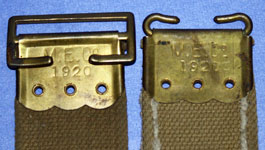
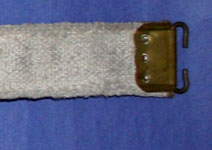 A.C.I. 36 / 1944 transferred the Sling from V.A.O.S. Section A1 to Section C1, which was announced by L. of C. §C415, approved on 10th June 1944. It was made obsolete by L. of C. §C2732, approved 16th August 1946, though this was for Land and Air Service only, leaving the Royal Navy as the only users. This M.E.Co. example is dated 1920. From the Ed Storey Collection. Photographs © Ed Storey 2012.
A.C.I. 36 / 1944 transferred the Sling from V.A.O.S. Section A1 to Section C1, which was announced by L. of C. §C415, approved on 10th June 1944. It was made obsolete by L. of C. §C2732, approved 16th August 1946, though this was for Land and Air Service only, leaving the Royal Navy as the only users. This M.E.Co. example is dated 1920. From the Ed Storey Collection. Photographs © Ed Storey 2012.
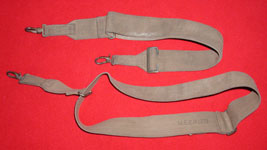
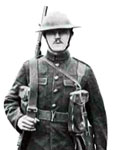 The Berthier Light Machine Gun was originally designed prior to WWI by French General Andre Berthier. It was tested and formally adopted by the US Army in 1917, but was never produced in the USA. In 1925, Vickers-Armstrong Ltd. bought the manufacturing rights, with the intent to market it to the British Army as a lighter complement to its Vickers-Maxim. The Mk. II version was tested by the military in competition with the Bren. Although it was simpler and easier to build it was also heavier and had a slower rate of fire. In the end, the Bren was chosen over the Vickers-Berthier by the British Army, but the Indian Army did adopt the Mk. III version. In anticipation that the V-B would be adopted, though, the Mills Equipment Company circa 1931 designed a set of web equipment intended to be used with it, including a Sling. Note the use of levered spring-hooks, as used in the R.A.F. Web Equipment for Officers. Two examples of this Sling, maker marked "M.E. Co." and dated 1931, are shown at left. These are from the Tom Ready Collection. At right is a photo from the Mills brochure produced to promote the Vickers-Berthier Equipment, showing the equipment in use, including the Sling. As an aside, the Magazine pouch from this equipment later was re-invented - classic Mills approach - as the W.E. Pattern 1937 Basic pouch. A 1931 dated example of the V-B Pouch is shown on the W.E. Patt. '37 Basic and Utility Pouches page.
The Berthier Light Machine Gun was originally designed prior to WWI by French General Andre Berthier. It was tested and formally adopted by the US Army in 1917, but was never produced in the USA. In 1925, Vickers-Armstrong Ltd. bought the manufacturing rights, with the intent to market it to the British Army as a lighter complement to its Vickers-Maxim. The Mk. II version was tested by the military in competition with the Bren. Although it was simpler and easier to build it was also heavier and had a slower rate of fire. In the end, the Bren was chosen over the Vickers-Berthier by the British Army, but the Indian Army did adopt the Mk. III version. In anticipation that the V-B would be adopted, though, the Mills Equipment Company circa 1931 designed a set of web equipment intended to be used with it, including a Sling. Note the use of levered spring-hooks, as used in the R.A.F. Web Equipment for Officers. Two examples of this Sling, maker marked "M.E. Co." and dated 1931, are shown at left. These are from the Tom Ready Collection. At right is a photo from the Mills brochure produced to promote the Vickers-Berthier Equipment, showing the equipment in use, including the Sling. As an aside, the Magazine pouch from this equipment later was re-invented - classic Mills approach - as the W.E. Pattern 1937 Basic pouch. A 1931 dated example of the V-B Pouch is shown on the W.E. Patt. '37 Basic and Utility Pouches page.
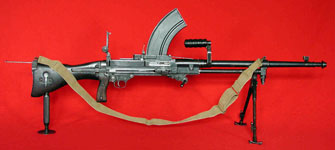 A Vickers-Berthier Mk. III, complete with Sling, also from the Tom Ready Collection. Both contemporary photos are © Tom Ready 2008.
A Vickers-Berthier Mk. III, complete with Sling, also from the Tom Ready Collection. Both contemporary photos are © Tom Ready 2008.
Stores Ref. A1/AA 1640 Sling, Bren gun comprising
Stores Ref. A1/AA 1657 Sling, rifle, web and
Stores Ref. A1/AA 1132 Hook, sling, Bren .303-in. M.G., Mk. 1
Stores Ref. A1/AA 1640 Sling, Bren gun comprising
Stores Ref. B1/AA 1657 Sling, rifle, web and
Stores Ref. C1/AA 1132 Hook, sling, Bren .303-in. M.G., Mk. 1
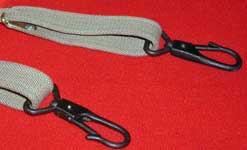 In the curious way the War Office sometimes have, the Bren sling was introduced earlier than the gun itself. The original form of Bren sling simply added hooks to the existing Sling, rifle, web. L. of C. §B1523, approved on 25th April, 1938, introduced a Sling for the Bren Gun, with an over-long nomenclature. The new Sling was created by the simple expedient of adding, to the Rifle sling, two large, heavy-duty Hooks, sling, Bren gun made of steel. The Hooks were a new design, specifically for use with the Bren, which had no Sling Swivels. L. of C. §B2380 had three approval dates of 23rd May, 1935; 17th January, 1938 and 4th August, 1938 and it ran to 38 pages across all three Parts of that month’s issue. It detailed all the accessories for the weapon and buried in the contents of the Chest, Bren .303-in. M.G., Mk. I was a more discrete (and shorter) nomenclature of Sling, Bren .303-in. M.G., Mk. I. The picture at left, showing a pair of Bren gun sling hooks, is from the Tom Ready Collection. Photograph © Tom Ready 2009.
In the curious way the War Office sometimes have, the Bren sling was introduced earlier than the gun itself. The original form of Bren sling simply added hooks to the existing Sling, rifle, web. L. of C. §B1523, approved on 25th April, 1938, introduced a Sling for the Bren Gun, with an over-long nomenclature. The new Sling was created by the simple expedient of adding, to the Rifle sling, two large, heavy-duty Hooks, sling, Bren gun made of steel. The Hooks were a new design, specifically for use with the Bren, which had no Sling Swivels. L. of C. §B2380 had three approval dates of 23rd May, 1935; 17th January, 1938 and 4th August, 1938 and it ran to 38 pages across all three Parts of that month’s issue. It detailed all the accessories for the weapon and buried in the contents of the Chest, Bren .303-in. M.G., Mk. I was a more discrete (and shorter) nomenclature of Sling, Bren .303-in. M.G., Mk. I. The picture at left, showing a pair of Bren gun sling hooks, is from the Tom Ready Collection. Photograph © Tom Ready 2009.
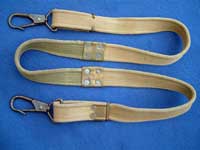 At 28 lbs odd, the Bren was angular and the Sling, at only 1 1/4-inches wide, had a very small bearing surface. It was also somewhat angular to have against the gunner’s back. The Sling was sometimes seen over the shoulder, but with the Bren being horizontal. At 46-inches, it was too short to use over the shoulder when firing. The Sling was eventually lengthened by inserting 12-inches of 11/4-in. beaded-edge webbing, an N.I.V. item. This was announced in Army Council Instruction (A.C.I.) 377 of 1944, which introduced a form of “fishplate”, GB 0078 Brass, sheet, No. 22 S.W.G. 3-in. x 1-in. coded in V.A.O.S. Section G2 Metals This was a section of pre-shaped brass sheet, 3 x 1 inch, with part-rolled ends and bent in half across the shorter dimension. The Rifle sling was cut in half and the new section inserted in-line, being held in place by the shaped “fishplates”, which were riveted in position. The extended Sling shown at right is from the Kevin Groom Collection. Photograph © Kevin Groom 2009.
At 28 lbs odd, the Bren was angular and the Sling, at only 1 1/4-inches wide, had a very small bearing surface. It was also somewhat angular to have against the gunner’s back. The Sling was sometimes seen over the shoulder, but with the Bren being horizontal. At 46-inches, it was too short to use over the shoulder when firing. The Sling was eventually lengthened by inserting 12-inches of 11/4-in. beaded-edge webbing, an N.I.V. item. This was announced in Army Council Instruction (A.C.I.) 377 of 1944, which introduced a form of “fishplate”, GB 0078 Brass, sheet, No. 22 S.W.G. 3-in. x 1-in. coded in V.A.O.S. Section G2 Metals This was a section of pre-shaped brass sheet, 3 x 1 inch, with part-rolled ends and bent in half across the shorter dimension. The Rifle sling was cut in half and the new section inserted in-line, being held in place by the shaped “fishplates”, which were riveted in position. The extended Sling shown at right is from the Kevin Groom Collection. Photograph © Kevin Groom 2009.
A.C.I. 36/1944 transferred the Rifle sling to V.A.O.S. Section B2 Small Arms Accessories, Tools and Packages – erroneously – when in actual fact it changed to section Section B1 Small Arms and their components. The Bren sling moved to Section C1 Machine Guns, Mountings and Appurtenances for Ground Service Use, along with the Hooks. L. of C. §C415 and §C416, both approved 10th June, 1944 reflected A.C.I. 36/1944 for the Bren sling and its hooks (§C415) and the Rifle sling (§C416), in the latter case contradicting the A.C.I., as it (correctly) quoted Section B1.
Stores Ref. C1/AA 1640 Sling, Bren .303-in. M.G., No. 1, Mk. 1
Stores Ref. B1/AA 1657 Sling, rifle, web, khaki drab
Stores Ref. BB 7116 Sling, rifle, web, khaki drab
Stores Ref. B1/1005-99-960-3065 Sling, rifle, web, khaki drab
Stores Ref. B1/AA 1657 Sling, rifle, web, olive drab
Stores Ref. B1/1005-99-960-3066 Sling, rifle, web, olive drab
Stores Ref. C1/AA 1132 Hook, sling, Bren gun (N.S.N. code t.b.d.)
Stores Ref. C1/AA 5663 Sling, Bren .303-in. M.G., No. 1, Mk. 2 (N.S.N. code t.b.d.)
Stores Ref. C1/AA 5663 Sling, M.G., Mk.1
Stores Ref. C1/CA 0737 Sling, web, 58-in., Mk. 1
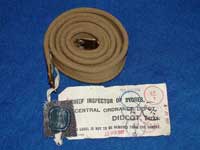
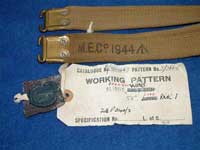 The composite Sling was finally replaced, post-war, when L. of C. §C2376, approved 8th November 1944 / 30th April 1946, introduced a Sling, web, 58-in., Mk. 1, which was used to make up a Sling, Bren .303-in. M.G., No. 1, Mk.2. The Sealed Pattern example of the Mk. 2 Sling shown left, maker marked "M.E. Co." and dated 1944, is from the Kevin Groom Collection. Photographs © Kevin Groom 2009. The original 46-inch Sling was re-designated as Sling, Bren .303-in. M.G., No. 1, Mk.1 and was declared obsolescent, but re-capturing its original nomenclature in the process. The Mk. 1 Sling was also scaled for a weapon in V.A.O.S. Section M1 Miscellaneous Weapons O.M.L. 2-in. mortars, Mks. 2 to 2** and Mk. 7. For the un-initiated, O.M.L. translated to Ordnance Muzzle Loading. Just as an aside, the Army – with typical inconsistency – termed the 3-in. Mortar as O.S.B. – Ordnance Smooth Bore!!! The Rifle sling’s obsolescence meant it survived into the era of Joint Service Catalogue Numbers, becoming B1/1005-99-960-3065, announced by L. of C. §C9369, approved 24th July, 1957 / 30th June, 1959. The same L. of C. introduced an olive drab Sling, both colours for use with the Bren, its tripod, Rifle Nos. 1, 2, 4 and 5 and 3.5-in Rocket Launchers and the new 7.62 mm S.L.R.. The olive drab type was restricted for use in jungle areas and with commandos and airborne personnel. Both colours had the same stores code AA 1657, until the khaki drab was deprived of its rightful code and given a “…local catalogue number BB 7116…”. What cheek – its code pinched by an upstart , Johnny-come-lately green sling! The example of the green version shown below left, maker marked "J.B.B." and dated 1958, is from the Rog Dennis Collection, photographs © Rog Dennis 2009.
The composite Sling was finally replaced, post-war, when L. of C. §C2376, approved 8th November 1944 / 30th April 1946, introduced a Sling, web, 58-in., Mk. 1, which was used to make up a Sling, Bren .303-in. M.G., No. 1, Mk.2. The Sealed Pattern example of the Mk. 2 Sling shown left, maker marked "M.E. Co." and dated 1944, is from the Kevin Groom Collection. Photographs © Kevin Groom 2009. The original 46-inch Sling was re-designated as Sling, Bren .303-in. M.G., No. 1, Mk.1 and was declared obsolescent, but re-capturing its original nomenclature in the process. The Mk. 1 Sling was also scaled for a weapon in V.A.O.S. Section M1 Miscellaneous Weapons O.M.L. 2-in. mortars, Mks. 2 to 2** and Mk. 7. For the un-initiated, O.M.L. translated to Ordnance Muzzle Loading. Just as an aside, the Army – with typical inconsistency – termed the 3-in. Mortar as O.S.B. – Ordnance Smooth Bore!!! The Rifle sling’s obsolescence meant it survived into the era of Joint Service Catalogue Numbers, becoming B1/1005-99-960-3065, announced by L. of C. §C9369, approved 24th July, 1957 / 30th June, 1959. The same L. of C. introduced an olive drab Sling, both colours for use with the Bren, its tripod, Rifle Nos. 1, 2, 4 and 5 and 3.5-in Rocket Launchers and the new 7.62 mm S.L.R.. The olive drab type was restricted for use in jungle areas and with commandos and airborne personnel. Both colours had the same stores code AA 1657, until the khaki drab was deprived of its rightful code and given a “…local catalogue number BB 7116…”. What cheek – its code pinched by an upstart , Johnny-come-lately green sling! The example of the green version shown below left, maker marked "J.B.B." and dated 1958, is from the Rog Dennis Collection, photographs © Rog Dennis 2009.
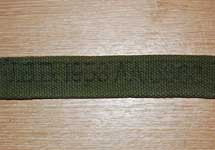
 The contents of L. of C. §C9501 were variously approved on 28th May and 2nd June 1958, 12th December 1958 and 5th October, 1959. Curiously, L. of C. §C9369 having allocated N.S.N. codes (N.A.T.O. Stock Number) to Rifle slings, this L. of C. reverted to the old V.A.O.S. codes for the Bren slings! The No. 1 Mk. 2 sling received a simplified nomenclature, Sling, M.G., Mk.1, as it was now used with the Bren .303-in. and 7.62 mm., L4A1 and L4A2 Bren Guns. L. of C. §C9501 also terminated the obsolescence of the No. 1 Mk. 1 sling and made it obsolete. The 58-in. Sling had a final lease of life was granted by L. of C. §D71, approved 28th May and 2nd October, 1962, which extended its use to the Machine Gun, 7.62 mm., L7A1 – the General Purpose Machine Gun, more usually known as the G.P.M.G. and affectionately as the “Jimpy”.
The contents of L. of C. §C9501 were variously approved on 28th May and 2nd June 1958, 12th December 1958 and 5th October, 1959. Curiously, L. of C. §C9369 having allocated N.S.N. codes (N.A.T.O. Stock Number) to Rifle slings, this L. of C. reverted to the old V.A.O.S. codes for the Bren slings! The No. 1 Mk. 2 sling received a simplified nomenclature, Sling, M.G., Mk.1, as it was now used with the Bren .303-in. and 7.62 mm., L4A1 and L4A2 Bren Guns. L. of C. §C9501 also terminated the obsolescence of the No. 1 Mk. 1 sling and made it obsolete. The 58-in. Sling had a final lease of life was granted by L. of C. §D71, approved 28th May and 2nd October, 1962, which extended its use to the Machine Gun, 7.62 mm., L7A1 – the General Purpose Machine Gun, more usually known as the G.P.M.G. and affectionately as the “Jimpy”.
The same observation is made, as with Rifle slings – 58-inches is not even “…nominal…”, some examples being several inches shorter.
Sub-Machine Gun Slings
Slings, S.M.G., Web, (Aust) (C1/CAA.3600)
Slings, Machine Carbine, Web, (Aust) (B3/CAA.3600)

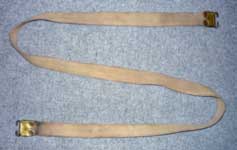 The Slings, S.M.G., Web, (Aust) was introduced by Australian Changes in War Materiel, under Section C1 LM No. 1219 of 31 Aug 1943. They were described as being similar to Slings, Rifle, Web, excepting that they are 57-inches in length. It was claimed that the extra length gave a better firing position and control when firing from the hip. Further details were to be found in the VAOS Supplement.
The Slings, S.M.G., Web, (Aust) was introduced by Australian Changes in War Materiel, under Section C1 LM No. 1219 of 31 Aug 1943. They were described as being similar to Slings, Rifle, Web, excepting that they are 57-inches in length. It was claimed that the extra length gave a better firing position and control when firing from the hip. Further details were to be found in the VAOS Supplement.
As was often the case the AC in WM lagged behind the actual date of introduction and the Slings, S.M.G. were certainly already in the hands of the troops before April 1943 when Equipment Memorandum No 4 was printed. Paragraph 5 of this publication advised that the Slings had been accepted for service & that Owen, Austen & Thompson Sub-Machine Guns were to be equipped with them.
As with any equipment there must have been a development stage. The earliest evidence so far is a May 1942 promotional booklet produced by Lysaght’s, the makers of the Owen Gun, entitled Owen Gun, Illustrations showing the use of the Sling. It contains only photos of a long plain Sling being used with the Owen in various positions & for various purposes. A similar Sling is illustrated above left and although it is only 54-inches long, it could well be the ancestor of the Sling S.M.G. Needless to say, without a beaded edge to lock the adjustment hooks in position it can only reliably be used at its full extent.
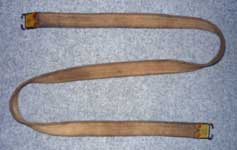
 The next example, although unmarked, conforms to the AC in WM description. The end fittings are secured with heavy copper rivets similar to the earlier example.
The next example, although unmarked, conforms to the AC in WM description. The end fittings are secured with heavy copper rivets similar to the earlier example.
By 1945 the use of SLING, S.M.G., web (Aust.) had been extended to the Bren Gun as the 1945 AMF Identification List GUN, MACHINE, BREN, .303-in., Mk.I and Mk.II lists it under the accessories. There appears to be no AC in WM entry announcing this widened usage.
In August 1946 Australian Changes in War Material AC No 3404 announced that consequent upon the decision to adopt the British nomenclature for the Machine Carbine, the nomenclature of the bayonet, scabbard, pull throughs and slings is amended. With this announcement Slings, S.M.G., Web, (Aust) became Slings, Machine Carbine, Web, (Aust) and were transferred from VOAS Section C1 Machine Guns, Mountings and Appurtenances for Ground Service use to B3 Machine Carbines and Appurtenances.
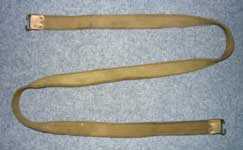
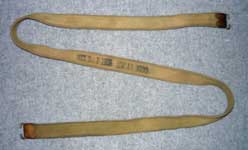
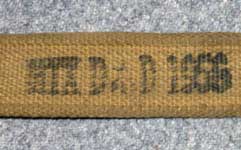 This example is a Slings, Machine Carbine, Web (Aust) made in the mid 1950’s by MTX (believed to be the mark of the Commonwealth Government Clothing Factory). These are often encountered and are clearly marked with the VAOS number. On these Slings the end fittings are affixed with brass eyelets.
This example is a Slings, Machine Carbine, Web (Aust) made in the mid 1950’s by MTX (believed to be the mark of the Commonwealth Government Clothing Factory). These are often encountered and are clearly marked with the VAOS number. On these Slings the end fittings are affixed with brass eyelets.

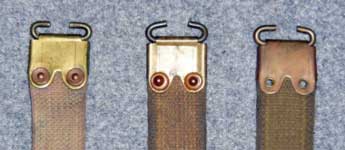 At left is a comparison of end fittings & rivet styles from the three Slings above. From the Graham Tweeddale collection. Photographs © Graham Tweeddale 2012.
At left is a comparison of end fittings & rivet styles from the three Slings above. From the Graham Tweeddale collection. Photographs © Graham Tweeddale 2012.
Curiously AC in WM 13470 of October 1956 introduced the SLINGS, Bren .303-in., MG, No 1, Mk. 2 (C1/AA 5663) into Australian service. Consisting of a pair of HOOKS, sling, Bren and a SLINGS, web, 58-in., Mk. 1 (C1/CA 0737) it lead to the strange situation of two near identical Slings, varying in length by only 1-inch, within the one system. How many were mixed up by unknowing or uncaring Diggers is anyone’s guess.
The last official mention of the Sling located to date (if an inexplicable 1969 reprint of the 1945 Bren Identification List is disregarded) is the Illustrated RAEME Maintenance Scale for Equipment, 9-mm OWEN machine carbine, Mk 2 1960, where curiously enough it is listed as SLING, S.M.G. web (Aust) 57-in but still with the B3/CAA 3600 stock number.
The Sling (or perhaps a Bren sling) is shown in illustrations in Infantry Training, Volume 1, Pamphlet No. 4A, Sub Machine Gun 9 mm F1 1966 but it rates no mention in the text. The KWRT have not been able to locate an F1 CES to confirm the Sling’s use with that weapon. Many Slings, S.M.G. may well have ended their days blacked for parade use with everything from Raven Oil to boot polish and mixed indiscriminately with rifle Slings, causing the odd Digger to wonder why his Sling was longer than his mates.
It is not known if the Slings ever acquired a NATO Stock Number or were just lumped in with the SLING, rifle, web. The end came in the late 1980’s with adoption of the Rifle F88 replacing both the Rifle, 7.62 mm L1A1 & SMG 9 mm F1 the last equipments in Australian service to use the Mills type Slings.